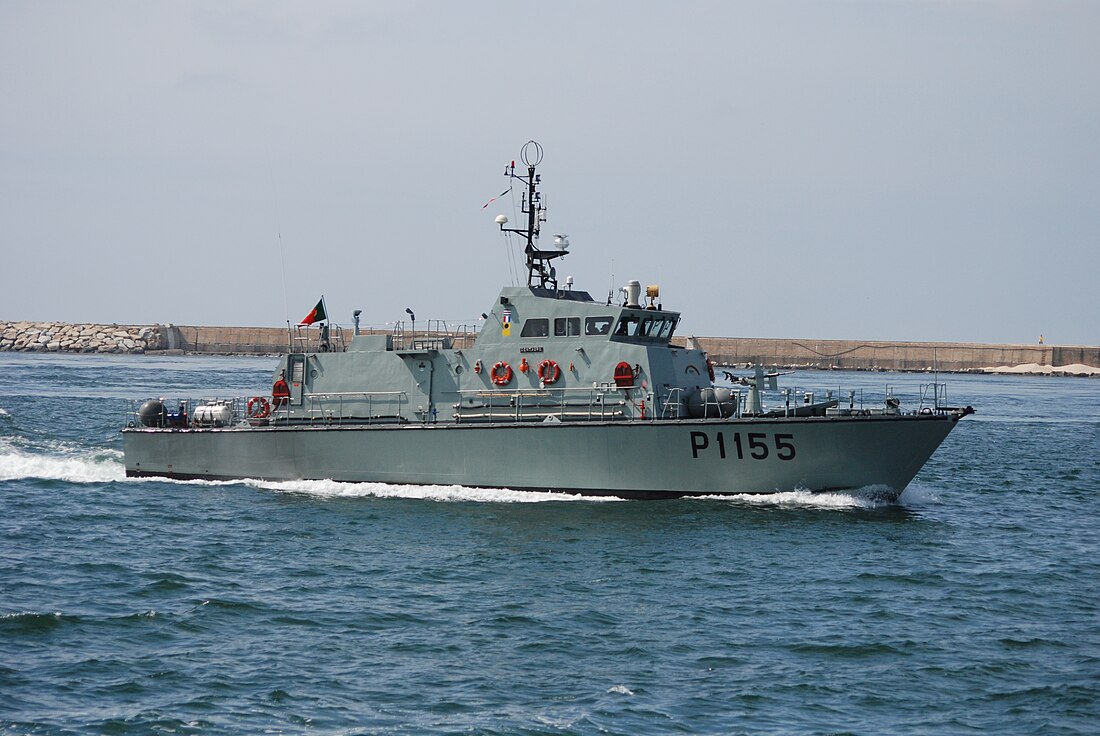Top Qs
Timeline
Chat
Perspective
Centauro-class patrol boat
Class of patrol boats in the Portuguese Navy From Wikipedia, the free encyclopedia
Remove ads
The Centauro-class patrol boat is a series of four patrol boats in service with the Portuguese Navy. It is an evolution of the preceding Argos class. This class is meant for fisheries inspection and control duties mainly in the Mainland Portugal shores – with some sporadic presence in the Madeira Archipelago. The Centauro class is Portuguese-designed and built at the Arsenal do Alfeite (Almada) and Estaleiros Navais do Mondego (Figueira da Foz).
Remove ads
Design and description
Summarize
Perspective
The Centauro-class patrol boats are an evolution of the Argos class, constructed of aluminium instead of the Argos' glass reinforced plastic design. The Centauro class measure 28.4 metres (93 ft 2 in) long with a beam of 5.95 m (19 ft 6 in) and a draught of 1.45 m (4 ft 9 in).[1][2][a] The patrol boats have a standard displacement of 82 tonnes (81 long tons) and 94 t (93 long tons) fully loaded.[2][3][b] The vessels are powered by two Cummins KTA-50-M2 diesel engines turning two shafts creating 2,700 kilowatts (3,600 hp). This gives the vessels a maximum speed of 26 knots (48 km/h; 30 mph), though they did make 28 knots (52 km/h; 32 mph) during sea trials.[2] They have a range of 1,350 nautical miles (2,500 km; 1,550 mi) at 15 knots (28 km/h; 17 mph)[3] or 640 nmi (1,190 km; 740 mi) at 20 knots (37 km/h; 23 mph).[1][2] The Centauros are equipped with two Cummins 6BT5.95(M) diesel generators producing 150 kW of electricity. The ships can operate in sea state 3.[1]
The patrol boats mount a single Oerlikon 20-millimetre (0.79 in)/70 Mk 4 gun for anti-air defence.[2] The ships were equipped with navigational radar only.[2][3] They also carry a 4 m (13 ft) launch carried on a launch-and-recovery ramp on the stern and the boat can be recovered at speeds up to 10 knots (19 km/h; 12 mph).[1][2] The vessels have a complement of eight, including one officer.[1][3][c]
Remove ads
Construction and career
The class were ordered in 1998 as an improved version of the Argos class.[2] They were designed and built in Portugal.[4] Upon entering service, the vessels were deployed for fisheries protection, search and rescue and general patrol. The Centauros take part in some naval exercises and some training.[3] In 2006, one boat of this class, NRP Sagitário, became the first Portuguese warship with a female commander, the second lieutenant Gisela Antunes.[5][6]
Remove ads
Ships
Notes
Remove ads
Citations
References
Wikiwand - on
Seamless Wikipedia browsing. On steroids.
Remove ads

